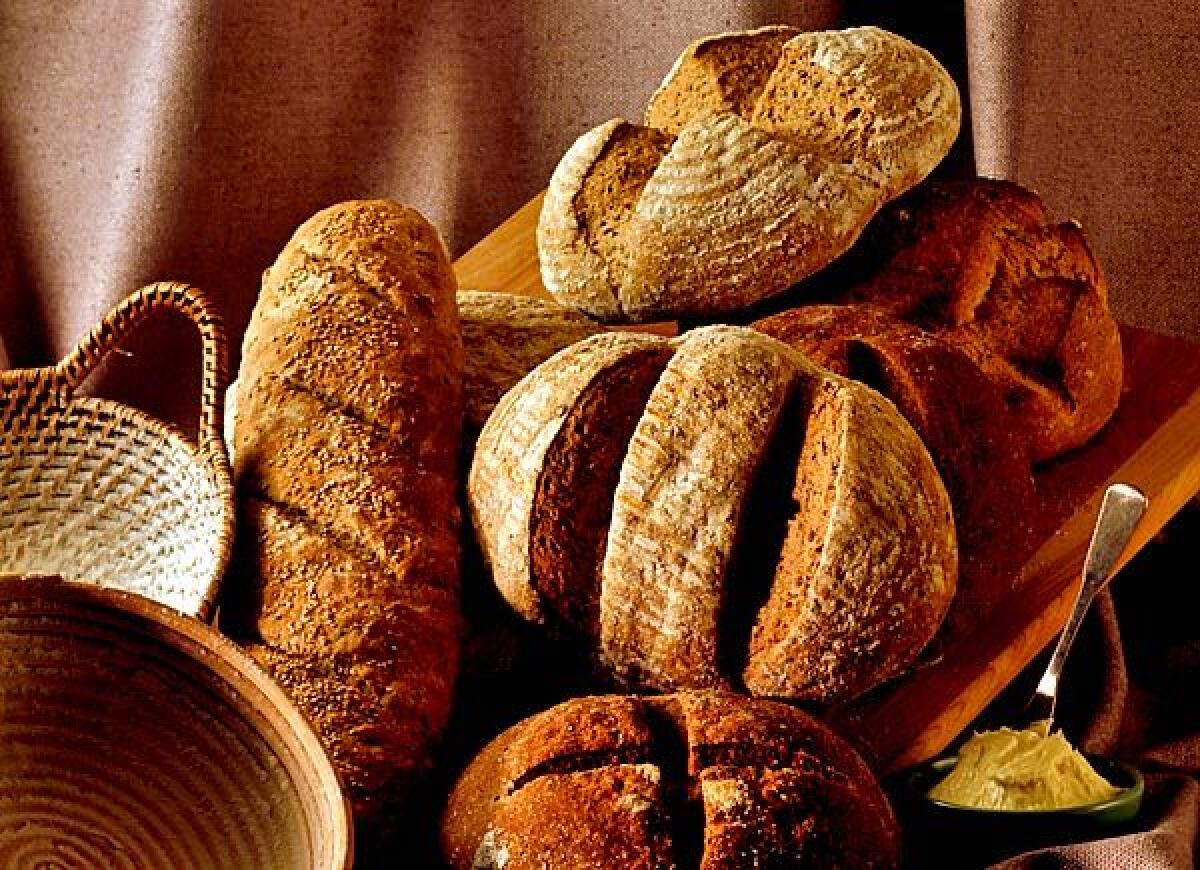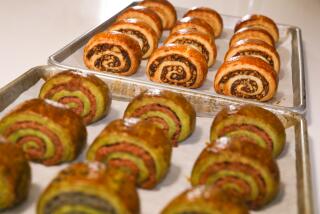Old-world breads boast layers of taste

- Share via
Unless you’re reading this story in your grandmother’s Brooklyn or Minnesota kitchen, a loaf of dark bread just out of the oven, you may be part of the vast majority of people for whom dense rye breads are a bit out of the comfort zone. You may run across old-world loaves like these, on your table if you’re lucky or maybe at a Vermont bakery, the loaves stacked in a dark mosaic, but in this country it’s mostly the more familiar baguettes and country whites that we buy and bake at home.
But if your experience of rye bread has been limited to grocery store loaves, then you’re missing out on something extraordinary. And if you’ve never baked breads like these — chewy ryes, dark breads studded with nuts and seeds, black pumpernickels layered with as many intricate flavors as a great ale or stout — then it’s not just a good loaf you’ve been missing, but a whole new world of baking. Or, more exactly, an old one rediscovered.
Loaded with flavor from whole grains, often from nuts or seeds, and sometimes from long hours on the oven floor, loaves of rye bread built the bakeries of northern and eastern Europe and migrated to this country with the bakers that created them. And although they can sometimes require a bit more technique than a loaf of white, and often a few more ingredients, they’re surprisingly easy to make at home.
The payoff? Loaves with stunning flavor, texture and depth. Breads that have complexity and staying power and the ability to pair with strong ingredients instead of fading into the background of a meal. Breads that can form the centerpiece of meals, almost the meal itself.
“When you get hooked” on rye breads, says master baker Peter Reinhart, “you really get hooked, just like when somebody falls for a strong IPA beer. Then all of a sudden nothing else satisfies you.”
The cornerstone of old-world breads like these is, of course, the flour. Instead of wheat, these are breads built with rye flour, as that grain could grow in the less hospitable climate. Rye is a hardier grain, and the flour is also more mercurial than wheat flour, with less gluten and more bran and fiber, which means the doughs absorb more water and have a tendency to become dense and gummy. For this reason, most rye breads are not made with 100% rye, but with a combination of wheat and rye. In fact, they can contain as little as 20% rye, depending on what else is in the dough.
The exception to this loose rule is sourdough rye bread, which is what most bakers who fall in love with rye bread usually end up baking, and which, of course, is a whole other story. By using sourdough, the acidity of which creates a small chemistry experiment in your bread bowl and oven, you can make loaves using all rye flour — beautiful, complex loaves that bear as much similarity to store-bought ryes as artisan-made baguettes do to Wonder Bread.
Sourdough starter, an active culture of yeast and flour and bacteria, controls the enzymatic activity of the rye flour with its natural acidity, preventing the crumb from getting gummy while adding a beautiful complex flavor to the bread. And since baking with sourdough isn’t any more difficult than baking without it — the hard part is making and achieving a strong starter — it’s worth considering as the logical next step in old-world baking.
“The real thing,” says certified master baker Jeffrey Hamelman, who started baking German breads 34 years ago and has represented the U.S. at the Coupe du Monde de la Boulangerie, “puts you on your knees.”
Sourcing good flour, always important in baking, becomes even more so, as rye flour — not as popular in this country as wheat — can quickly grow rancid if left too long on a store (or a home) shelf. Buy flour from a reliable source and store it in the freezer.
A good loaf of rye, like Rose Levy Beranbaum’s Real Jewish Rye, requires very little more than a percentage of rye flour, a bit of malt syrup (you can use honey or even table sugar), yeast, flour, salt and water. Throw in a handful of caraway seeds, as Beranbaum does, or omit the seeds entirely. Caraway is wonderful, with a lovely anise flavor, but it can easily overwhelm the subtle milky notes of the rye flour.
Indeed, this simplicity is part of the reason home-baked rye is so good. Traditionally, black breads and pumpernickels were baked overnight, using the residual heat of the oven, and get their distinctive color from a long, slow caramelization of the bread itself in the oven. Short-cut commercial ryes get their hue from caramel colorings and are laden with fillers that mask the true flavor of the breads.
These badly made breads can put you off the real thing for good. “My relatives in Russia used to tell me that black bread was used to plug door holes,” said Beranbaum recently from her New York apartment (a faint symphony of sirens and snowplows in the background).
But done well, with balance and proportion, baking a simple rye bread at home, even without a sourdough starter or a massive Teutonic oven, can be revelatory.
“For me the key was the seeds,” Reinhart says of baking old-world breads at home. “Seeds have so much flavor and they give you an excuse for having a dense bread.” Not only do seeds and nuts add flavor, but they ratchet up the nutritional value and shelf life of the bread. (Nuts and seeds can be toasted for added flavor, but don’t toast them if you’ll be sprinkling them over the bread, as they’ll burn during baking.)
Seeds and nuts also give bread a lovely long finish, Reinhart says. “After you eat sesame seeds in a bread, the flavor lingers for a really long time.”
But although seeds help compensate for not having sourdough in a bread, they also suck up a lot of the moisture in a dough, as does the rye flour itself. Many traditional rye or multigrain bread recipes call for a soaker, which is pretty much what you’d think it would be: an additional step in which seeds, grain, whole grains or whole-grain flours are first soaked before being added to the dough. This step is needed because these ingredients often require more time to fully hydrate than they’d get during ordinary mixing and rising time.
Because of issues of hydration, it’s important not to overcompensate by adding too much flour while kneading these doughs, which can be very dense but should not be stiff. This is one reason why making dark breads is often easier with a Kitchen-Aid or other mixer.
“In the beginning I did everything by hand,” says baker Beth Hensperger, author of “The Bread Bible.” “’Oh no,’ I thought, ‘you need to connect with the ingredients.’ But when you have these whole-grain sticky doughs, the electrical appliances really come in handy.”
Mixing doughs by machine may not give you the same 19th century feel as kneading by hand, but it will ensure that you don’t add too much flour as the dough comes together.
And if you’re not already in the habit of weighing your ingredients, now is the time to invest in an inexpensive kitchen scale, as the different flours, as well as the brans, whole grains, seeds and nuts, can easily throw off a recipe unless they’re pretty accurately measured.
Another tip if you’ve just discovering these breads, points out Reinhart, is to divide up the dough into rolls instead of making a few large loaves. Rolls are easier to make and to control, and the dark, flavorful breads make fantastic sandwich rolls.
Dense, chewy rye and seeded breads also toast up extraordinarily well: Pair them with nubs of butter and good jams or marmalades, maybe a generous spoonful of Nutella. Beranbaum suggests topping her rye bread with unsalted butter, sliced radishes and big flakes of salt. Or turn slices of black bread into open-face or smorgasbord sandwiches, loaded with smoked fish or salumi. Even break off pieces and dip them into a pot of Swiss fondue, as they’ll hold up better than flimsy bits of French bread.
You’ll soon see that you don’t have to hop on a plane to Germany or live next to a New England artisan baker to discover the joys of freshly baked old-world bread: All you really need is a good recipe, a little patience and a pocketful of rye.
More to Read
Eat your way across L.A.
Get our weekly Tasting Notes newsletter for reviews, news and more.
You may occasionally receive promotional content from the Los Angeles Times.











